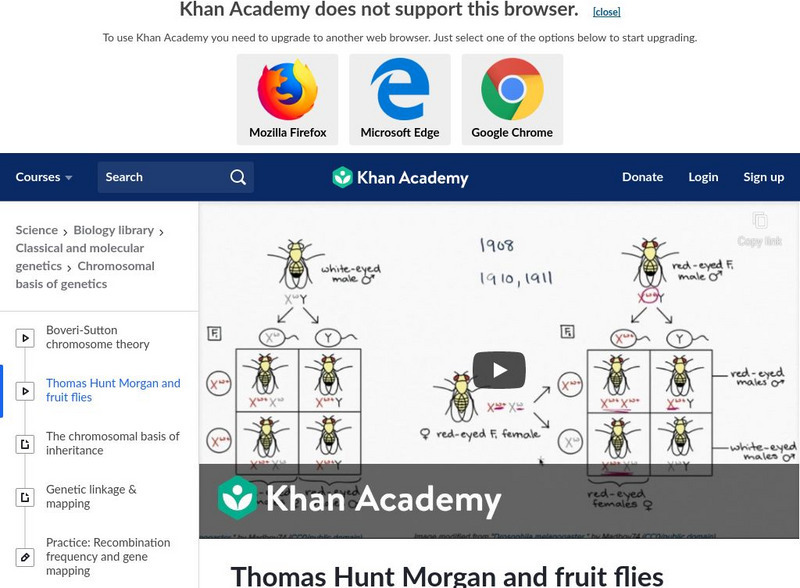Hi, what do you want to do?
Visual Learning Systems
Traits and Heredity: Inherited Traits
Upon viewing the Traits and Heredity video series, students will be able to do the following: Define traits as the distinguishing characteristics of an organism. Describe heredity as the process of passing on traits from parents to...
Visual Learning Systems
Investigating Heredity: Inherited Traits
This fascinating program helps students understand the basics of heredity. Acquired traits and inherited traits are defined and contrasted. Special emphasis is placed on some easy to understand human traits that are inherited. Concepts...
TED-Ed
The Cancer Gene We All Have
What is cancer? And why don't we all have it? These concepts are explored and tumor suppressor genes are introduced in this animated feature. This nutshell of information is fully packed and makes an outstanding resource for your biology...
Howard Hughes Medical Institute
The Making of the Fittest: Natural Selection in Humans
Sickle cell disease only occurs when both parents contribute the trait, and mostly in those of African descent. Where did it come from? How did it evolve? Tony Allison, a molecular biologist, noticed a connection between sickle cell and...
Howard Hughes Medical Institute
The Making of the Fittest: Got Lactase? The Co-evolution of Genes and Culture
Got milk? Only two cultures have had it long enough to develop the tolerance of lactose as an adult. Learn how the responsible genes evolved along with the cultures that have been consuming milk. This rich film is supplied with a few...
TED-Ed
How Mendel's Pea Plants Helped Us Understand Genetics
A brief animation introduces heredity to your beginning biologists. They will meet Gregor Mendel's green and yellow peas, dominant and recessive traits, homozygous and heterozygous alleles, and Punnett squares. In this cartoon animation,...
Khan Academy
DNA
The picture of the DNA double helix provides a logical start to describing how the base pairs match up and how the order codes for a chain of protein molecules—three billion of these base pairs code for any protein present in your body....
PBS
When Rodents Rafted across the Ocean
You think mice can be a nuisance, wait until you meet the capybara! An installment of the PBS Eons series traces the genetic background of a large group of rodents known as the Caviomorpha. Fossil evidence indicates they originate in...
PBS
The Two People We're All Related To
Is it possible all current lineage trace back to one male and female? Mitochondria DNA suggest just that! A lesson with this interesting perspective on genetic heredity explains how all human DNA connects to a single male and female in...
Amoeba Sisters
DNA, Chromosomes, Genes, and Traits: An Intro to Heredity
Chromosomes, genes, traits ... how are they all related? A short video introduces the many factors involved in heredity. Junior geneticists explore the transfer of chromosomes from parents to offspring, the proteins created by base pair...
Teach Engineering
The Grand Challenge: Fix the Hip Challenge
It may be time to get to know the skeletons in your family. The first lesson in a series of 5, introduces the class to the concept of osteoporosis. The class members brainstorm possible causes and whether the family should be concerned...
Crash Course
Heredity
Ear wax, either wet or dry, is inherited on chromosome 16. The narrator of a video about heredity uses ear wax to introduce the concepts of alleles, dominant and recessive traits, and heterozygous and homozygous genotypes.
TED-Ed
Why Are Some People Left-Handed?
Despite what some may think, being right- or left-handed isn't a conscious choice people make. Watch this short video to find out exactly what determines a person's dominant hand, and how the cooperative and competitive nature...
TED-Ed
Where Do Genes Come From?
No, you didn't get your genes from the local clothing store. Learn where they really come from by watching this video as it explores how the genes found in all plants and animals today have arisen over...
PBS
Pbs Learning Media: The Common Genetic Code
Paul Nurse describes his research that showed that humans share some genes with organisms as different from us as simple brewer's yeast. Footage from Secret of Life: "Immortal Thread." [4 min, 20 sec]
CK-12 Foundation
Ck 12: Punnett Squares: Punnett Square Fun
[Free Registration/Login may be required to access all resource tools.] In this Kahn Academy video, learn about Punnettt squares, with specific information on dihybrid crosses, independent assortment, incomplete dominance, codominance,...
Khan Academy
Khan Academy: Thomas Hunt Morgan and Fruit Flies
Thomas Hunt Morgan's pioneering fruit fly work that helped validate the chromosomal theory of inheritance. [10:40]
Khan Academy
Khan Academy: Introduction to Evolution and Natural Selection
Introduction to how groups of organisms evolve and how natural selection can lead to evolution. [17:39]
CK-12 Foundation
Ck 12: Gregor Mendel and Genetics: Mendelian Genetics Overview
[Free Registration/Login may be required to access all resource tools.] Expose students to the story of Mendel and his pea plants, and introduce genetics and the study of trait inheritance. [1:56]
University of Utah
University of Utah: Learning Center: learn.genetics: Epigenetics: Lick Your Rats
Play the role of a mother rat and lick your pup to see how your nurturing behavior shapes his epigenome. This interactive helps students visualize the nature vs. nurture debate.
University of Utah
University of Utah: Learning Center: learn.genetics: Epigenetics: Twins
Investigate the role the environment plays on gene expression through studies on identical twins. Contains video (4:41).
PBS
Pbs Learning Media: Double Immunity
Dr. Stephen O'Brien of the National Cancer Institute discovers a 700-year-old mutation that makes a person resistant to HIV infection. From Evolution: "Evolutionary Arms Race."
PBS
Pbs Learning Media: Human Genome Project
This video segment from NOVA: "Cracking the Code of Life" looks at the meaning and significance of the effort to decode the human genome. [4:08]
PBS
Pbs Learning Media: A Mutation Story
This video segment describes the role of the sickle cell gene in natural selection. Footage courtesy of the PBS series Secret of Life: "Accidents of Creation." [4:49]























